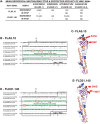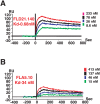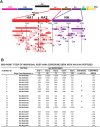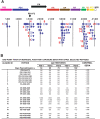Antigenic fingerprinting of H5N1 avian influenza using convalescent sera and monoclonal antibodies reveals potential vaccine and diagnostic targets
- PMID: 19381279
- PMCID: PMC2661249
- DOI: 10.1371/journal.pmed.1000049
Antigenic fingerprinting of H5N1 avian influenza using convalescent sera and monoclonal antibodies reveals potential vaccine and diagnostic targets
Abstract
Background: Transmission of highly pathogenic avian H5N1 viruses from poultry to humans have raised fears of an impending influenza pandemic. Concerted efforts are underway to prepare effective vaccines and therapies including polyclonal or monoclonal antibodies against H5N1. Current efforts are hampered by the paucity of information on protective immune responses against avian influenza. Characterizing the B cell responses in convalescent individuals could help in the design of future vaccines and therapeutics.
Methods and findings: To address this need, we generated whole-genome-fragment phage display libraries (GFPDL) expressing fragments of 15-350 amino acids covering all the proteins of A/Vietnam/1203/2004 (H5N1). These GFPDL were used to analyze neutralizing human monoclonal antibodies and sera of five individuals who had recovered from H5N1 infection. This approach led to the mapping of two broadly neutralizing human monoclonal antibodies with conformation-dependent epitopes. In H5N1 convalescent sera, we have identified several potentially protective H5N1-specific human antibody epitopes in H5 HA[(-10)-223], neuraminidase catalytic site, and M2 ectodomain. In addition, for the first time to our knowledge in humans, we identified strong reactivity against PB1-F2, a putative virulence factor, following H5N1 infection. Importantly, novel epitopes were identified, which were recognized by H5N1-convalescent sera but did not react with sera from control individuals (H5N1 naïve, H1N1 or H3N2 seropositive).
Conclusion: This is the first study, to our knowledge, describing the complete antibody repertoire following H5N1 infection. Collectively, these data will contribute to rational vaccine design and new H5N1-specific serodiagnostic surveillance tools.
Conflict of interest statement
The authors have declared that no competing interests exist.
Figures





Comment in
-
Mapping antibody epitopes of the avian H5N1 influenza virus.PLoS Med. 2009 Apr 21;6(4):e1000064. doi: 10.1371/journal.pmed.1000064. Epub 2009 Apr 21. PLoS Med. 2009. PMID: 19381281 Free PMC article.
References
-
- Gambotto A, Barratt-Boyes SM, de Jong MD, Neumann G, Kawaoka Y. Human infection with highly pathogenic H5N1 influenza virus. Lancet. 2008;371:1464–1475. - PubMed
-
- Luke TC, Kilbane EM, Jackson JL, Hoffman SL. Meta-analysis: convalescent blood products for Spanish influenza pneumonia: a future H5N1 treatment? Ann Intern Med. 2006;145:599–609. - PubMed
Publication types
MeSH terms
Substances
Grants and funding
LinkOut - more resources
Full Text Sources
Other Literature Sources
Medical
Miscellaneous

